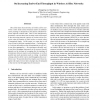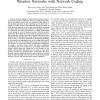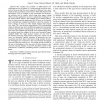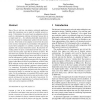19 search results - page 3 / 4 » On the Throughput Capacity of Opportunistic Multicasting wit... |
QSHINE
2005
IEEE
13 years 11 months ago
2005
IEEE
One of the main characteristics of wireless ad hoc networks is their node-centric broadcast nature of communication, leading to interferences and spatial contention between adjace...
INFOCOM
2009
IEEE
13 years 12 months ago
2009
IEEE
—Network coding is a method that promises to achieve the min-cut capacity in multicasts. However, pushing towards this gain in throughput comes with two sacrifices. Delay suffer...
TCOM
2008
13 years 5 months ago
2008
We consider the problem of differentiated rate scheduling for the downlink (i.e., multi-antenna broadcast channel), in the sense that the rates required by different users must sat...
DFG
2009
Springer
13 years 12 months ago
2009
Springer
s of the work of our research group are given in the following poster of the final meeting. Network Coding Network Coding has emerged as a new paradigm that has influenced Inform...
SIGCOMM
1996
ACM
13 years 9 months ago
1996
ACM
State of the art, real-time, rate-adaptive, multimedia applications adjust their transmission rate to match the available network capacity. Unfortunately, this source-based rate-a...




